#Bdx17: The Médoc, part II
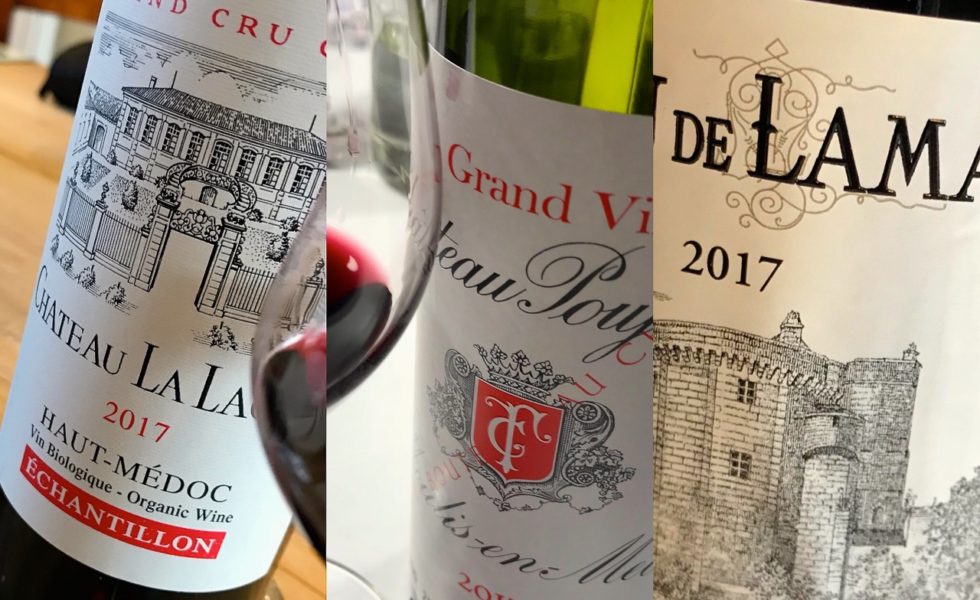
Assessing Haut-Médoc, Listrac-Médoc and Moulis-en-Médoc
By Panos Kakaviatos for wine-chronicles.com
21 May 2018
This section on #Bdx17 from barrel focuses on three Médoc appellations not as famous as those in Part I but known for quality wines at generally lower prices.
Certain wines here indeed could constitute bargains… in the longer run. And as we saw with Part I, most of these “see the river” but this is not a hard and fast rule, as you can read in the tasting notes ?.
My overall favorite in this section? Château La Lagune. It retails for about $50 in futures. I suppose that is on the high side, taking into account taxes and delivery charges, but it did very well in 2017.
Château Cantemerle is a close second place. But one of the wines that really excelled, for its caliber, was Château de Lamarque, whose price as of this writing is not yet released. I suspect it will be lower than that of either Cantemerle or La Lagune, both of which are “classified growths” of already celebrated reputations.
Already Château Poujeaux – the best of the Moulis-en-Médoc I tasted from barrel – has been released for a rather reasonable $30.
In any case, these brands are readily available off-the-shelf in bottle in earlier vintages, some more successful than 2017, and for similar pricing. So no urgent need to tie up your money up for two or three years before you get the 2017s. This is not a speculative vintage. The 2015s and 2014s, both fine vintages, are available now.
Whatever you decide, it is important to note how these 2017s performed, for future reference.
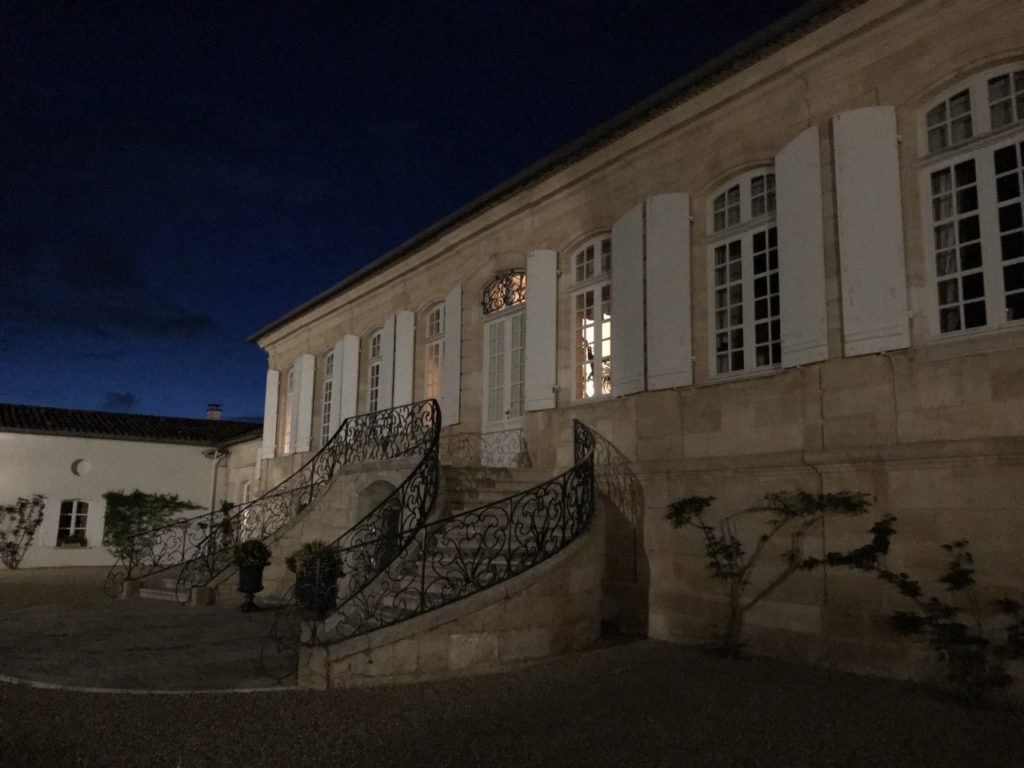
The elegant facade of Château La Lagune by night. The estate produced arguably the best AOC Haut-Médoc wine in 2017.
In order of preference for each appellation, with the usual preference for wines in bold. And, if red and bold, even more.
Listrac-Médoc
Château Fonréaud – Spice and depth on the palate. Ripe plum, albeit there is a certain “just ripe enough” plum impression indicating that ripeness was not optimally achieved here. 88-90
Château Clarke – Ripe enough fresh nose of plum. Ripe enough notions on the palate; not a large scaled vintage. But refreshing. Should be fine with steak. 87-89+
Château Fourcas Dupré – This seems a bit more firm than the two preceding wines, on the nose. The palate is not as concentrated and while the tannins are not hard, they are hardly soft. 87-88
Château Fourcas Hosten – Just ripe enough. The palate is pleasant, albeit a certain hollowness on the mid palate. 85-87
Moulis-en-Médoc
Château Poujeaux – The most successful of the Moulis, albeit more closed at the UGCB than it was at the Joanne negociant tasting. Still, one senses the most density among these three Moulis wines. At Joanne, I got jammier fruit on the nose from this blend of 62% Cabernet Sauvignon, 25% Merlot and 13% Petit Verdot. Not as long as the 2015, which I had tried the month before, for an article to be published in Decanter. 33% new oak for this vintage, and the extraction seems judicious. Fine! Not as good as the 2015, mind you, but smooth. They must have had frost damage given low yields of 26 hectoliters per hectare. 90-92
Château Maucaillou – A bit riper expression of fruit as compared to the Chasse Spleen. More an inner core of fruit. Frank and fine at the UGCB. Tasted also at the negociant Joanne, the clean nose is appreciable as is the mid palate suppleness. There is a bit of oak tannin perhaps that dries out, at least the oak derivation seems just a bit too prominent on the finish. Otherwise, fine. The estate blends 52% Cabernet Sauvignon, 41% Merlot and 7% Petit Verdot, and it, too, was also affected by the frost. 89-91
Château Chasse-Spleen – At the UGCB, this was not really singing. Sure, there is ripe enough fruit but the tannins come across quite firm, lacking sumptuousness and not really chasing away the spleen in this vintage. Tasted again at the negotiant Joanne, only 40% new oak aging, but we were not sure about this vintage. In any case, you feel it. What the heck? Time in glass does it justice, but it seems more “spent” than Poujeaux, for example, which comes across as more robust, more vivacious. 87-89
Haut-Médoc
Château La Lagune – Certified organic and the wine comes across as the most pure expression of fruit of all wines on this Part II page. Damson and blackberry. Bright. But also a refined aspect, and very smooth on the palate. A certain “arc of tension” that is more interesting than, say, La Tour Carnet. Tasted also at the château, and it was lovely. I also tasted the 2016, which has one level more of opulence and body. 92-94
Château Cantemerle – Gives close competition to La Lagune. Lovely nose, quite intensely fruit driven. The palate has richness but on the fresher side, and that’s not bad at all. This is an estate where barrel aging will accentuate the richness, broaden the palate. I suspect it will turn into a lovely, supple wine, perfectly reflecting a modern era 1985, as stressed in one of my earlier postings on the vintage here. 91-93
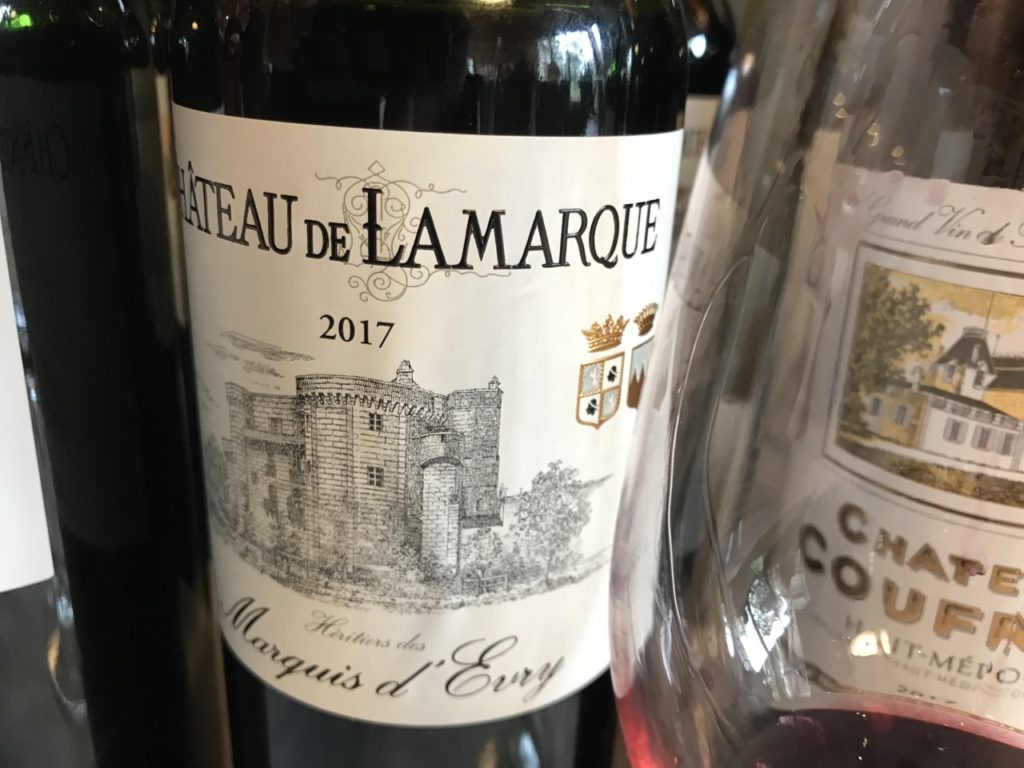
A wine to seek once on the shelf. If the in-bottle performance matches the barrel tasting, bien sûr ?… Tasted at the negociant Vintex and at the UGCB with similar, positive results.
Château de Lamarque – Just lovely rich and juicy fruit, from the onset presaged by an engagingly ripe fruit nose, through to the cooler fruit finish, marked by lift. Really, folks, if you see this on the shelves once in bottle, and if it fulfills the barrel tasting promise: do not hesitate because it should not be too pricey. 90-92+
Château La Tour Carnet – At the UGCB, a lovely nose, very rich and fruit driven. Lip smacking delicious. Although, sure, you do get some “sturdy” tannins on the finish. Tasted at Joanne with similar results: Sweet nose. The mid palate – rather rich – is more substantial. This does shows more breed than many other wines tasted at Joanne from the Haut-Médoc. Juicy, too. The oak is well integrated here. Nice job! you can buy with confidence. 90-92
Château Sociando Mallet – Normally I get more enthusiastic about this wine. OK, I loved the purity of fruit initially on the nose. But the palate is different: tad tight and even austere on the finish. One gets a sense of linearity and less breadth. Not as ripe as La Tour Carnet in this vintage, for example. The purity of fruit is laudable, as expected, but it lacks enough body to break into a “red zone” this time… We shall see from bottle! 89-91+
Château Belgrave – Somewhat muted nose; could it have been the tasting atmosphere? This has a certain brightness of fruit however on the palate that appeals. Another sample proves more ample, but not as pristine and as broad on the palate as La Lagune, tasted again, and both compared at the UGCB tasting. 89-91+
Château Lanessan – Blending 52% Cabernet Sauvignon, 38% Merlot and 10% Petit Verdot, and clocking in at 12.8% alcohol, this estate lost some 45% of potential production to frost, but has created a supple and even rather full bodied palate. There is juiciness and the finish is fairly long and not drying. Nicely done! About €10 ex-château, so this is not going to be a pricey wine. Keep that in mind for future reference. 89-91+
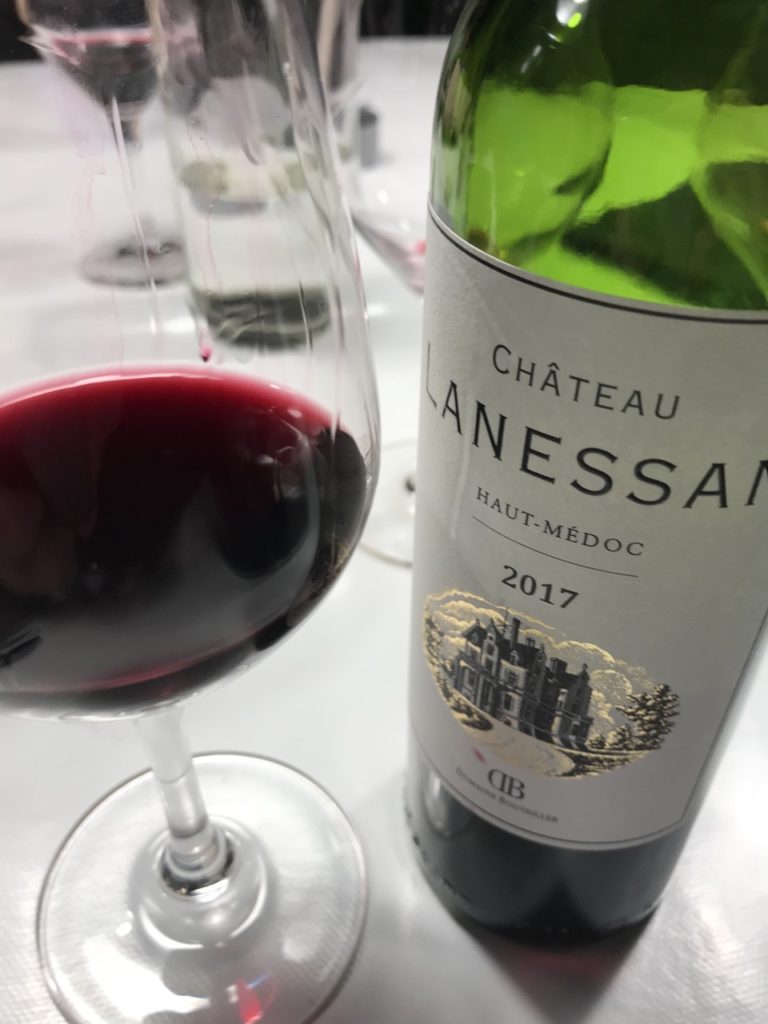
Despite frost damage, Lanessan turned out yet another fine wine in #bdx17 from barrel: tasting at the negociant Joanne
Château Belle-Vue – Tasted at Vintex and one gets the impression of winemaking “playing it safe” as the wine is not audacious or particularly remarkable but it does have pleasing aromatics of ripe fruit, a pleasing medium bodied mid palate, with a certain richness, and a fine finish. 89-91
Château Beaumont – Considering the ex-cellar price at under 9 euros, this is not bad. Nose is a bit closed. Adequate. Has body, and some substance. Far better in terms of price than a preceding wine from Cotes de Castillon fetching nearly twice as much. The body conveys a certain succulence. Solid. A bit more of Merlot than Cabernet Sauvignon typically, and maybe some Petit Verdot? Overall, as with Lanessan, worth seeking off shelf down the road. 89-91
Château Les Grands Chênes – Blending 70% Merlot and 30% Cabernet Sauvignon, this estate, further inland than Château Lagrange in Saint Julien, exudes richness on the mid palate, but dries out just a bit on the finish. It does have that Bernard Magrez plump mid palate signature. On balance, he did a decent job – for his style. Shortish finish, however. As Jane Anson commented: “Well handled.” Tasted also at the negociant Vintex, with similar, positive results. 89-91
Château Bernadotte – Tasted just after the Belle-Vue, and while I like the dark (ripe) fruit on the nose and juiciness on the palate, the tannins come across a bit more austere, detracting from the overall pleasing picture. 88-90
Château Larrivaut – The blend of just under 60% Merlot about 30% Cabernet Sauvignon, some 9% Petit Verdot and the rest Cabernet Franc reveals a rather nuanced and spicy nose. The palate has a more “streamlined feel” than that of Beaumont, tasted just before at the negociant Joanne. There is a certain austerity to the tannin, but – like Beaumont – this should soften and is not underripe. A slight underripe aspect. This estate is not far from Château Lafon Rochet in Saint Estèphe, but just over three kilometers further inland. 88-90
Château Citran – Ripe and spicy nose. This has a bit of a strict and firm delivery however. Not one of the worst in this style. Should open up a bit with barrel aging. Tasted at the negociant Joanne, with somewhat of a better impression. Point is: no reason to buy this en primeur when plenty of Citran bottles from better vintages are available now. 87-89
Château Coufran – A bit of soy like nose, when tasted at the UGCB and I did not get the impression of the palate reflecting this estate’s self description as the “Pomerol of the Médoc” in this vintage, as the Merlots may have been a bit underripe. The sunless summer? How about the frost? Perhaps that affected the outcome? A better tasting experience however at Vintex, but pales as compared to de Lamarque, tasted just afterwards. 87-89
Château Cambon La Pelouse – A bit greener in tannin, here. Certainly as compared to, say, Lanessan. The estate lost about 50% of the potential harvest to frost for this blend of 54% Cabernet Sauvignon, 40% Merlot and 6% Petit Verdot. Again, it comes across somewhat stemmy and raw. Give it time in bottle and it should be ok. Tasted again at the negociant Vintex, with similar results. 87-88
Château d’Agassac – Normally performs better, but this time (tasted at the negociant Vintex) the overall impression reflected somewhat hard tannins. Sure, there is fruit, but it lacks enough charm to engage the taster. Tried again, and a slightly better impression, but really pales as compared to, say, Château de Lamarque. Both “see the river” so I am not sure why the difference. 87-88
Part III for the Médoc, focusing on Margaux, is now online, too.
Category: Blog Tagged: Bdx17, Bordeaux, Château Cantemerle, Château de Lamarque, cru bourgeois, Haut Médoc, La Lagune, Listrac-Médoc, Moulis-en-Médoc
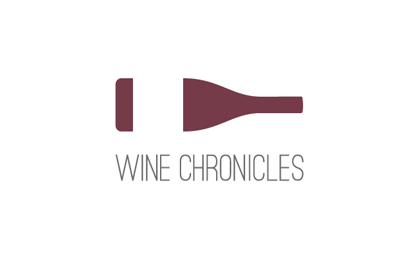 Wine Chronicles
Wine Chronicles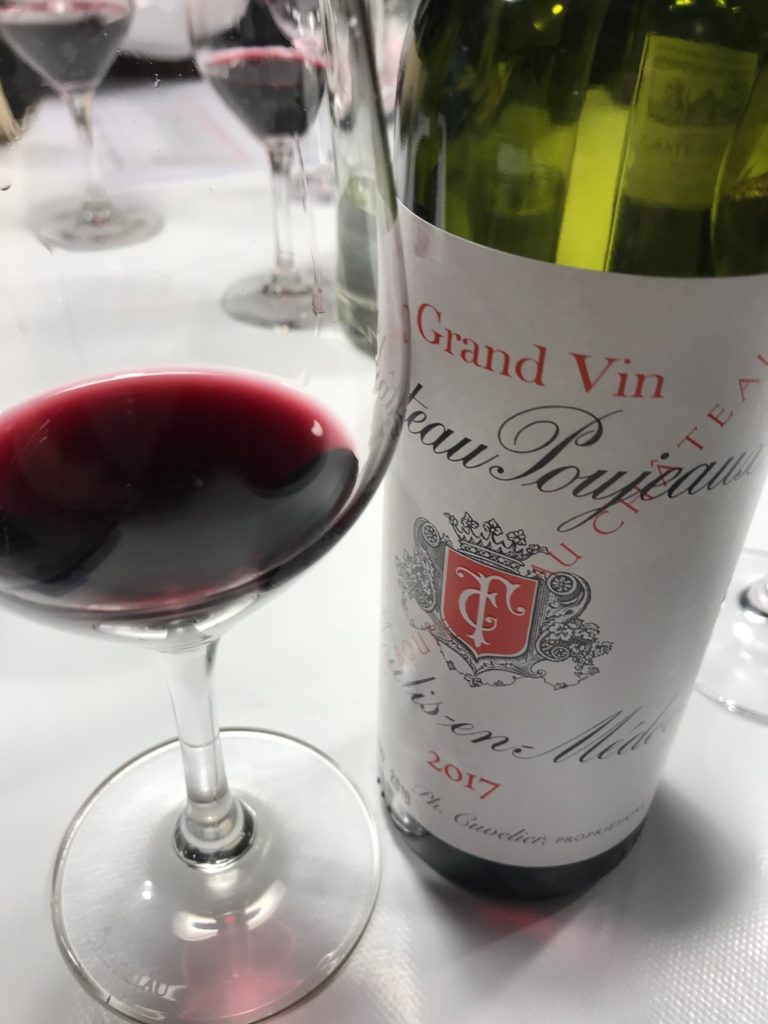
Share This